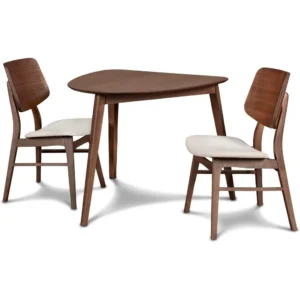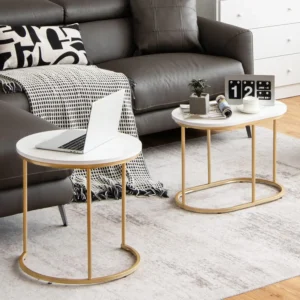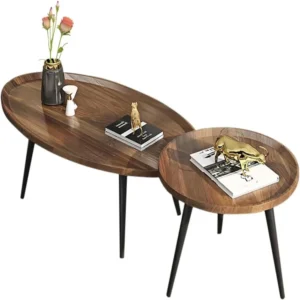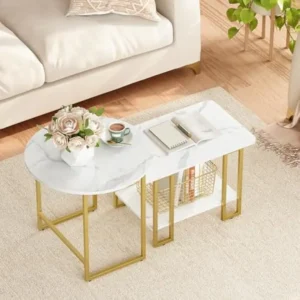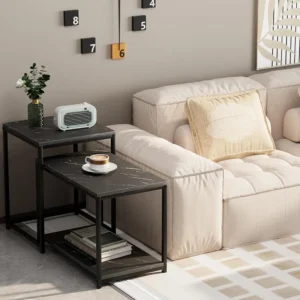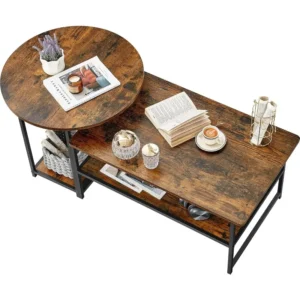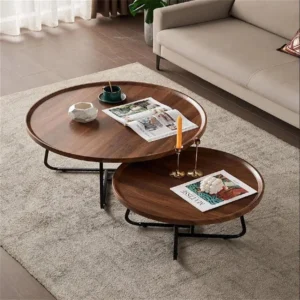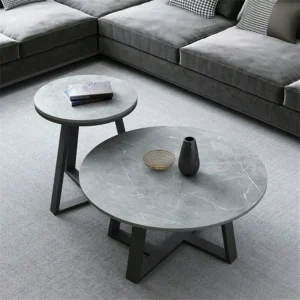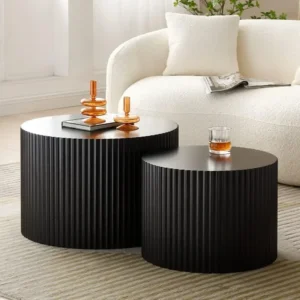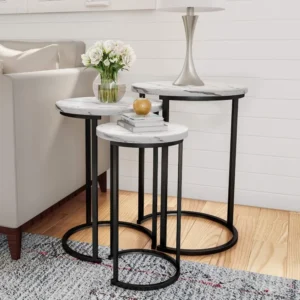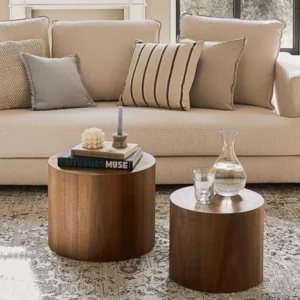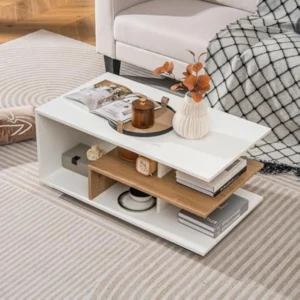Mid-Century Modern Nesting Table Sets
Enjoy stylish, space-saving solutions. Mid-century modern nesting table sets offer versatile tops for small spaces, adapting easily from chic display to practical serving.
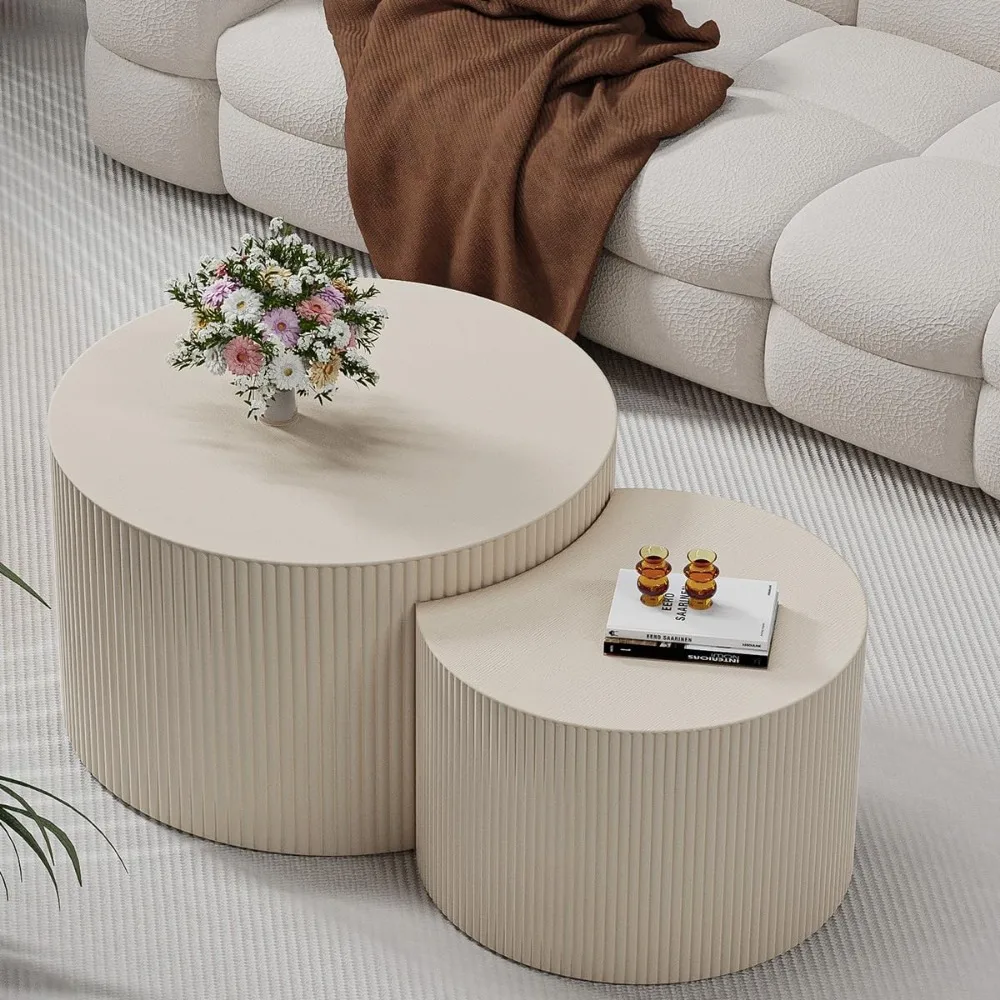
Showing 1–12 of 17 results
Mid-Century Modern Coffee Table Sets, Mid-Century Modern Nesting Table Sets
$662.76 Select options This product has multiple variants. The options may be chosen on the product pageMid-Century Modern Nesting Coffee Tables, Mid-Century Modern Nesting Table Sets
$361.45 Select options This product has multiple variants. The options may be chosen on the product pageMid-Century Modern Nesting Coffee Tables, Mid-Century Modern Nesting Table Sets, Mid-Century Modern Oval Coffee Tables, Mid-Century Modern Round Coffee Tables
$268.47 Select options This product has multiple variants. The options may be chosen on the product pageMid-Century Modern Coffee & End Table Sets, Mid-Century Modern Marble Top Coffee Tables, Mid-Century Modern Nesting Table Sets
$252.04 Select options This product has multiple variants. The options may be chosen on the product pageMid-Century Modern Marble Top Coffee Tables, Mid-Century Modern Nesting Coffee Tables, Mid-Century Modern Nesting Table Sets
$178.08 Select options This product has multiple variants. The options may be chosen on the product pageMid-Century Modern Coffee Table Sets, Mid-Century Modern Nesting Coffee Tables, Mid-Century Modern Nesting Table Sets
Price range: $325.75 through $340.88 Select options This product has multiple variants. The options may be chosen on the product pageMid-Century Modern Coffee Table Sets, Mid-Century Modern Nesting Table Sets, Mid-Century Modern Round Coffee Tables
$271.80 Select options This product has multiple variants. The options may be chosen on the product pageMid-Century Modern Marble Top Coffee Tables, Mid-Century Modern Nesting Coffee Tables, Mid-Century Modern Nesting Table Sets, Mid-Century Modern Round Coffee Tables
$498.39 Select options This product has multiple variants. The options may be chosen on the product pageMid-Century Modern Black Coffee Tables, Mid-Century Modern Nesting Table Sets, Mid-Century Modern Round Coffee Tables, Mid-Century Modern Round Side & End Tables
$751.54 Select options This product has multiple variants. The options may be chosen on the product pageMid-Century Modern Black Coffee Tables, Mid-Century Modern Marble Top Coffee Tables, Mid-Century Modern Nesting Coffee Tables, Mid-Century Modern Nesting Table Sets, Mid-Century Modern Round Coffee Tables
$410.44 Select options This product has multiple variants. The options may be chosen on the product pageMid-Century Modern Nesting Side & End Tables, Mid-Century Modern Nesting Table Sets, Mid-Century Modern Round Side & End Tables
Price range: $239.35 through $273.06 Select options This product has multiple variants. The options may be chosen on the product pageMid-Century Modern Nesting Table Sets, Mid-Century Modern Round Coffee Tables
$462.57 Select options This product has multiple variants. The options may be chosen on the product page
Showing 1–12 of 17 results
Mid-Century Modern Design Heritage
The mid-century modern movement represents one of design history’s most influential periods, spanning roughly from the 1940s through the 1970s. During this transformative era, designers embraced clean lines, organic forms, and functional minimalism—principles that continue to captivate homeowners and designers alike. This post-war period sparked unprecedented innovation in furniture design, with creators responding to urban living challenges through ingenious space-saving solutions.
Nesting tables emerged as a perfect embodiment of mid-century philosophy: maximum functionality with minimal visual weight. These clever designs feature signature elements like tapered legs, gentle organic curves, and thoughtful material combinations that speak to the era’s balance of form and function. Rather than mere furniture, these pieces represent functional art—objects designed to serve practical purposes while making clear aesthetic statements.
At Hearth Forms, we view nesting table sets as quintessential examples of mid-century innovation, where every element serves both aesthetic and practical purposes, creating timeless pieces that feel as relevant today as when first conceived.
Space-Saving Elegance for Modern Living
Today’s living spaces often demand furniture that works twice as hard, especially in urban apartments and compact homes. Mid-century modern nesting tables excel precisely in these environments, offering remarkable versatility within minimal footprints. When nested together, these tables create a cohesive visual statement while occupying the space of just one table. When needed, they can be separated to serve multiple purposes throughout a room.
This space-saving design makes nesting tables ideal for contemporary homes where flexibility matters. Place them beside a sofa as a unified end table solution, then separate them when entertaining to provide convenient surfaces for guests across the room. Their graduated heights create visual interest whether displayed together or apart, allowing you to reconfigure your space according to changing needs without compromising on style.
The genius of these designs lies in how they balance prominent aesthetic presence with practical space management—an approach that resonates perfectly with today’s design-conscious yet space-limited homes.
Versatile Functionality Beyond Display
Mid-century nesting tables transcend their decorative role by offering remarkable functional versatility throughout your home:
- Create tiered display platforms for plants, books, and treasured objects
- Provide multiple serving surfaces during gatherings and parties
- Function as occasional work surfaces for laptops or writing
- Serve as bedside tables with varying heights for different needs
- Offer supplemental surfaces when entertaining that store away when not needed
- Create visual rhythm through graduated heights when arranged separately
This adaptability allows these pieces to evolve with your changing needs. Their lightweight design makes them easy to reposition, while their sturdy construction ensures they perform reliably in any role. Unlike single-purpose furniture, nesting tables provide solutions for diverse situations—from everyday living to special occasions—making them one of the most practical investments in your mid-century modern collection.
Signature Materials & Craftsmanship
The enduring appeal of mid-century nesting tables lies largely in their exceptional materials and craftsmanship. Traditional sets often feature rich hardwoods like walnut with its deep, chocolate tones, teak known for its natural oils and resilience, or oak prized for its distinctive grain patterns. These woods were selected not just for their beauty but for their ability to age gracefully over decades.
Quality sets are distinguished by meticulous joinery—look for finger joints, dovetail construction, and mortise-and-tenon connections that signal superior craftsmanship. Metal elements typically feature tapered legs in brushed brass or sleek chrome, while surface materials might include glass for lightness, marble for sophistication, or laminate for durability and bold color.
Contemporary interpretations often maintain these material traditions while incorporating modern manufacturing techniques that enhance durability. The best examples honor traditional craftsmanship while meeting today’s expectations for quality and longevity—an approach we embrace wholeheartedly at Hearth Forms, where each piece is evaluated for authentic material expression and construction integrity.
Style Variations Within the Mid-Century Aesthetic
Mid-century modern nesting tables encompass a surprising diversity of styles within their design family. Danish and Scandinavian-influenced designs typically feature warm woods, organic shapes, and minimal ornamentation—creating an approachable elegance through simplicity. American mid-century interpretations often incorporate bolder geometric forms, contrasting materials, and more dramatic proportions reflecting the optimistic post-war American aesthetic.
Shape variations include perfect circles that create gentle visual flow, triangular forms that maximize corner spaces, and rectangular designs that offer more surface area. Leg designs range from delicate hairpin metal supports to substantial tapered wooden legs with characteristic angles, each creating distinct impressions of visual weight and stability.
Surface treatments further distinguish different style variations, from seamless wood veneer tops showcasing continuous grain patterns to two-tone finishes that highlight structural elements. Some designs incorporate subtle inlaid patterns or contrasting wood species to create visual interest while maintaining mid-century restraint.
Shape & Size Considerations
Selecting the right nesting table configuration depends largely on your space dimensions and intended use. Consider these typical dimensions when planning:
| Configuration | Typical Largest Table | Typical Smallest Table | Ideal Room Size |
|---|---|---|---|
| 2-Piece Sets | 24″ wide x 20″ high | 18″ wide x 16″ high | Small to medium |
| 3-Piece Sets | 28″ wide x 22″ high | 16″ wide x 14″ high | Medium to large |
Round nesting tables create better flow in tight spaces, allowing easier movement around corners and softening room layouts dominated by rectangular furniture. Rectangular or square sets provide more stable surface area for practical use but require more clearance space.
For optimal functionality, maintain at least 18 inches between tables and seating, ensuring comfortable access. Consider your room’s proportions—oversized sets can overwhelm small spaces, while undersized tables may appear insignificant in larger rooms and fail to provide adequate surface area.
Styling Your Nesting Tables: Designer Tips
Create visual rhythm by partially nesting tables rather than fully concealing smaller pieces, allowing each table to be visible while maintaining a cohesive footprint.
Balance height variations by placing taller objects on smaller tables and lower objects on larger tables, creating visual equilibrium across the arrangement.
Incorporate organic elements like potted plants or natural wood objects to soften the geometric precision of mid-century tables.
Layer textures thoughtfully by contrasting smooth table surfaces with tactile elements like ceramic vessels, textured books, or woven baskets.
Maintain negative space around and between tables to preserve their distinctive silhouettes—avoid overcrowding with too many decorative objects.
When styling nesting tables in living areas, consider functional needs first, ensuring space for essentials like reading materials or beverages, then add decorative elements. In bedrooms, prioritize practical items like reading lamps or alarm clocks on the most accessible surfaces.
Seasonal rotation of decorative elements keeps these versatile pieces feeling fresh while maintaining their timeless mid-century foundation.
Mixing With Other Furniture Styles
Mid-century nesting tables excel as “bridge pieces” that connect different design aesthetics throughout your home. Their clean lines and organic forms complement contemporary furniture by adding warmth and character without competing for attention. When paired with traditional pieces, they introduce modern sensibility while their wood tones maintain visual harmony.
For successful style mixing, identify connecting elements—perhaps the warm wood of your nesting tables echoes the tones in a traditional chest, or their metallic accents complement contemporary lighting fixtures. Scale matters tremendously; ensure your nesting tables’ proportions work with surrounding furniture, neither dwarfed by larger pieces nor overwhelming delicate ones.
Color coordination creates cohesion across different styles. The neutral palettes typical of mid-century nesting tables make them particularly adaptable, allowing them to pick up complementary tones from nearby textiles or artwork while maintaining their distinctive character.
Our Collection: From Classic to Contemporary
Hearth Forms’ nesting table collection spans from faithful reproductions of iconic designs to contemporary interpretations that honor mid-century principles. Each set undergoes rigorous evaluation against our design authenticity standards, ensuring proper proportions, quality construction, and genuine material expression.
Our selection includes:
- Classic walnut three-piece sets with graduated heights and gentle tapered legs
- Glass-topped designs with sculptural wooden bases that showcase craftsmanship
- Mixed-material sets combining wood, stone, and metal elements
- Compact two-piece configurations ideal for urban apartments
- Statement pieces featuring distinctive inlays or unexpected geometric forms
Explore our complete range of Mid-Century Modern Table Sets and nesting side tables to discover options that complement your existing furnishings while bringing authentic mid-century design into your home.
Frequently Asked Questions
What’s the difference between nesting tables and nesting coffee tables?
Nesting coffee tables typically feature larger dimensions suitable for central placement in seating areas, while standard nesting tables are sized for end table or side table use. Coffee table versions often include just two pieces, while side table sets frequently feature three or more graduated tables.
What weight can mid-century nesting tables typically support?
Quality sets support 25-35 pounds per table, though this varies based on construction. Wood-topped models generally offer higher weight capacity than glass-topped versions.
Can I mix individual tables from different sets?
While possible, maintaining visual cohesion requires careful attention to proportions, materials, and finish colors. Sets designed together ensure harmonic relationships between pieces.
Where is the best place to position nesting tables in a small living room?
In compact spaces, consider using the largest table as a main side table beside seating, keeping smaller nested pieces tucked underneath until needed, rather than permanently positioning all pieces separately around the room.

